THE FC CHASSIS GAME
Change is inevitable. It’s
safe to say this year in Funny Car we’ve already heard more about chassis
changes than we did in the last decade.
Why is that?
There are two influencing
factors in today’s racing world – safety and performance.
In this scenario, the
issue appears to be more of a performance issue.
“I think it boils down to
some drivers switched over to the slip-tube chassis because we though they were
easier to drive,” Gary Scelzi said. “Now some of the drivers are switching back
to the solid car.”
There are two chassis
being employed in today’s Funny Car division – the age-old rigid and the new
kid on the block, the slip-tube chassis.
The difference between the
two is that rigid, as implied, has all of the junctions welded and doesn’t move
to a great degree while a slip-tube car has sleeves around the frame rails at
the tube junctions. The uprights and cross members are welded to those sleeves
which are free to rotate around the rails thus making the chassis more limber.
Those sleeves are located longitudinally by short sleeves that are welded in
place at their extremities so that the chassis does not flex beyond pre
determined limits.
Why are Funny Car chassis changes more prevalent now?
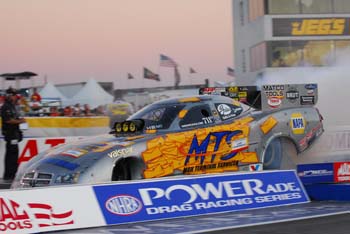
Why is that?
There are two influencing
factors in today’s racing world – safety and performance.
In this scenario, the
issue appears to be more of a performance nature.
“I think it boils down to
some drivers switched over to the slip-tube chassis because we though they were
easier to drive,” Gary Scelzi said. “Now some of the drivers are switching back
to the solid car.”
There are two chassis
being employed in today’s Funny Car division – the age-old rigid and the new
kid on the block, the slip-tube chassis.
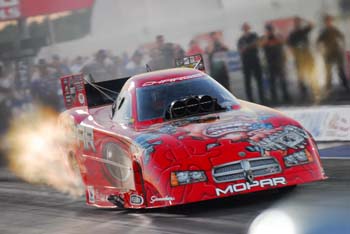
The traditional rigid
design gives no play apart from the flex in the tubes themselves while the
slip-tube allows the chassis to move around some.
Once considered the wave
of the future, many teams are returning to the original formula.
Torco’s
CompetitionPlus.com Funny Car expert Keith Burgan said many of the teams he
talked with are returning to the rigid frame.
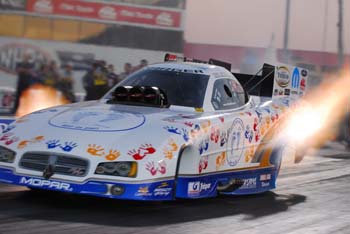
“You can always tell a car that has a slip-tube chassis from one that has a
rigid. If you watch when the car launches off the start line, on a slip-tube
car the injector moves over about two inches, appreciably more than with a
rigid frame. The frame twists up. The frame is flexible because of the way the
tubes are connected.
“It’s like having a box
with closed ends as opposed to one with open ends. It will diamond a bit more
in the front.”
Burgan said one of the
trends lately has been for some of the teams to weld the sleeve where the
upright from the front of the motor comes down to the bottom rail. He said that
seems to make many of the cars work better. It probably slows the diamond
action down a little but still allows quite a bit of movement at the other
junctions.
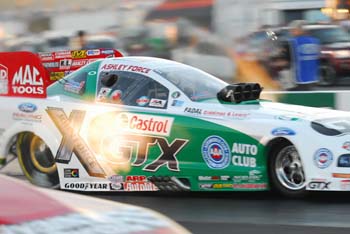
Burgan said this migration
back should not be an indication of racers losing faith in the combination.
“It’s mostly personal
preference and how the crew chief wants the car to work,” said Burgan. “Some of
them felt the slip-joint combination was not the way to go and others are
sticking with it.”
Burgan said he recently
had Kenny Bernstein’s Monster Energy Drink-sponsored Funny Car in his shop and
the slip-joints were welded.
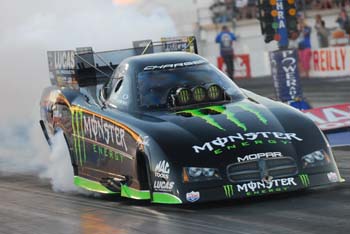
“The slip-joint was hot
for a while because some of the people who had them were running well. As soon
as it stalled out, many came back.”
Among those who made the
switch from rigid to slip-tube and back to rigid were John Force and Robert
Hight. All of Don Schumacher Racing’s Funny Cars are slip-tube combinations
except one which has transitioned back.
Burgan said a rigid
chassis on average will deliver more runs than a slip-tube before it expires.
He said the life depends on the respective team.
Jack Beckman has tested a
new slip-tube chassis this week and plans to debut the new car in
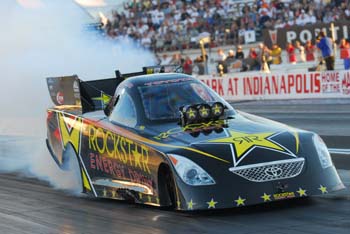
According to Don
Schumacher, he takes a chassis out of the rotation after 200 runs.
Burgan says that varies
from team to team and admitted he’s seen at least one rigid chassis out there
that has been running in competition since 2001.
“I think the jury is out
on which is better,” Burgan said. “It’s the age old tradition that if you give
six people the same piece, half of them will like it and half won’t for various
reasons. That’s until someone comes along with something better.
“The smart crew chief will
sit back and figure why one is better than the other. It’s not always because
someone changes a chassis. Lots of times it’s because the tuner has a better
handle on his combination. The Funny Cars are sometimes a can of worms.”



































